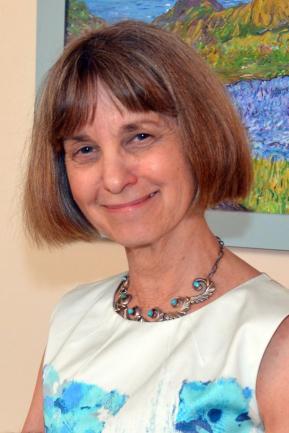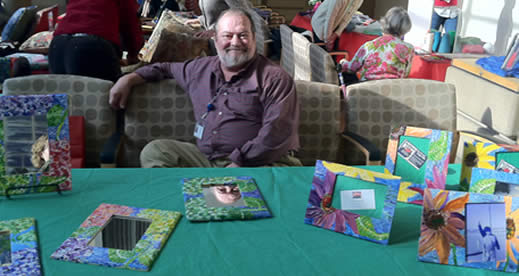Retiring Program Director Brought 'Art of Healing' to Georgetown

JULY 5, 2014—Cheerful artwork brightens the walls of Georgetown Lombardi Comprehensive Cancer Center (new window), and it is not uncommon to hear soothing harp or piano music in the lobby or infusion clinics. Every Tuesday evening, a writing group gathers to find their unique voices by expressing thoughts and feelings about life issues. People with cancer, caregivers and health care staff meet for painting, dance, stretch, yoga and guided meditation sessions throughout the week.
All these activities and many others are woven into the fabric of the cancer center. The creative architect behind all this is Nancy Morgan, the director of Georgetown Lombardi’s Arts and Humanities Program (new window), who has retired after 13 years of service.
Georgetown Lombardi bid farewell to Morgan at a June 18 reception. Colleagues, people with cancer and family members gathered to celebrate the artistic imprint she has left on the cancer center—and her drive to infuse both calm and beauty into a setting that might otherwise be sterile and stressful.
“Nancy personifies a really important concept here at Georgetown—it is cura personalis, which means ‘care of the whole person,’” says Georgetown Lombardi’s director, Louis M. Weiner, MD (new window). “Cancer is not just a disease; it affects a person, a caregiver, a family, a psyche. By having this wonderful resource of the Arts and Humanities Program available to our patients, their families and our caregivers, we have helped to ensure that we are in fact attending to the whole person, and not just treating a disease.”
Healing Power of Art
Morgan had years ago witnessed the healing power of the arts while working with artists in education in Arlington County Schools. She was moved by immigrant children who were able to put down roots in their new country by writing poetry.
She came to Georgetown Lombardi to work on a practicum for her master’s degree in transformative language arts, a form of therapeutic writing. Morgan then came on board in 2001 when Georgetown received a grant from the Prince Charitable Trusts to fund a part-time, onsite director for Lombardi Arts and Humanities Program.
The program, established by Kathy Russell and Helen Orem more than a decade before, grew quickly over the years thanks to Morgan’s efforts to secure additional funding from The Robert M. Fisher Memorial Foundation, the Joseph E. and Marjorie B. Jones Foundation, The Josie King Foundation and other organizations that recognized the importance of reducing stress and improving morale through the arts.
By 2003, Morgan’s job had expanded to full time and the program grew to offer a variety of activities every weekday.
A subsequent gift from the Prince family established the Frederick Henry Prince IV Family Hospital Morale Program, designed specifically for health care providers to address the emotional impact of caring for hospital patients.
A cadre of talented painters, quilters, dancers, yoga instructors and other creative professionals and volunteers offer a wide range of programming throughout the hospital and medical center.
“The healing power of art has the same impact in a medical environment as it does in schools and other settings. People benefit from the opportunity to express themselves in ways that alleviate emotional distress, strengthen a sense of self and clarify what is important to them,” says Morgan.
Additional funding over the years from grants, gifts, and art sales has helped make the Georgetown Lombardi arts and hospital morale program one of the most diverse in the country.
“That is one of Nancy’s gifts to all of us. In addition to the extraordinary local influence this program has had, it has also become an national paradigm that others have sought to emulate,” Weiner says.
Transformations Through Expression

Nevin Bossart, a visual artist and cancer survivor, is a regular presence at Georgetown Lombardi. Patients and staff have grown accustomed to seeing him, and Morgan has found over the years that cancer patients and their families try to schedule their visits when Bossart sets up his paints at the art table in the clinic.
“A patient said recently that although she was not happy to have to return for more treatment, she looked forward to her chats and painting with Nevin,” Morgan says.
She says visiting artists strive to help people enjoy the day “while giving them the tools to manage thoughts and feelings during and after treatment.”
Morgan, who has published studies in scholarly journals demonstrating the power of expressive writing to improve health, has seen first hand the transformations that occur when individuals pick up pen and paper.
“Given the chance to express themselves, participants move from being anxious, fearful and angry to calm, accepting and grateful,” she says. “As one study participant said, ‘Don’t get me wrong, cancer is no gift, but it taught me what the gifts in my life are.’”
Future Plans
In her retirement, Morgan plans to pursue her own writing. She hopes to return, this time as an artist, to continue the writing program part-time, while leaving the Arts and Humanities program management in the hands of her successor, Julia Langley.
“I love the Lombardi community and admire the people who find the courage to express themselves through writing and other arts,” says Morgan. “I now look forward to devoting my time to writing.”
By Lauren Wolkoff and Renee Twombly
GUMC Communications
